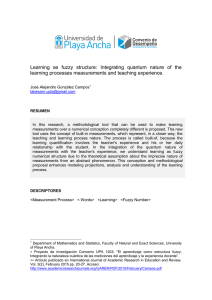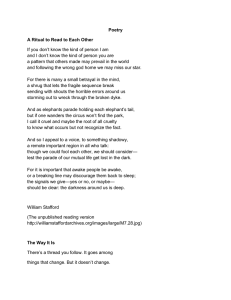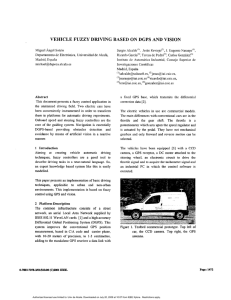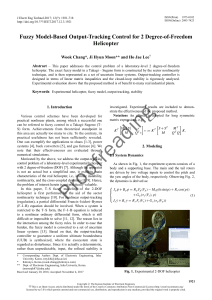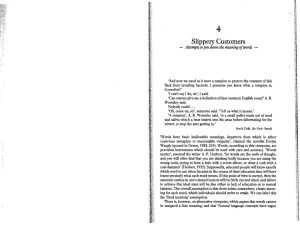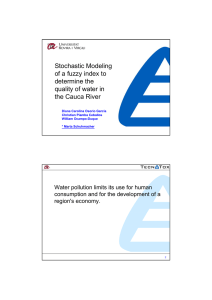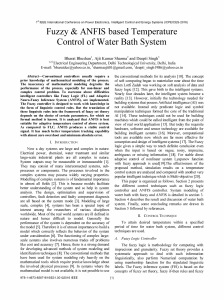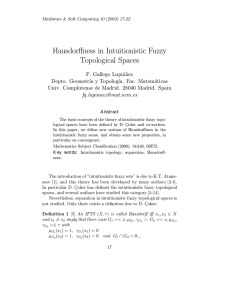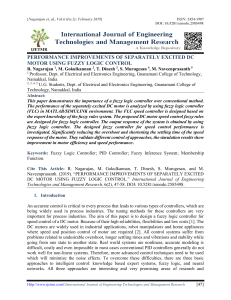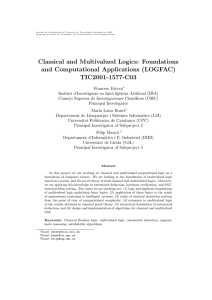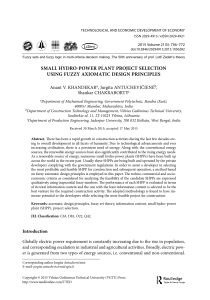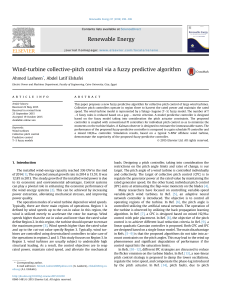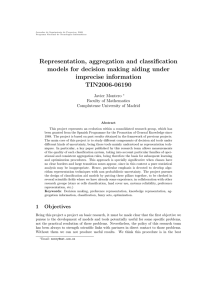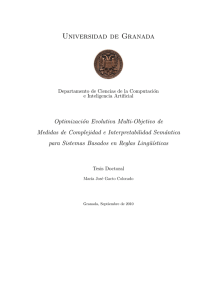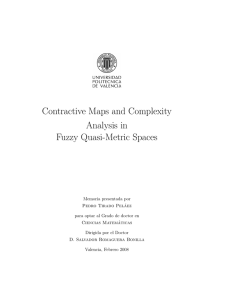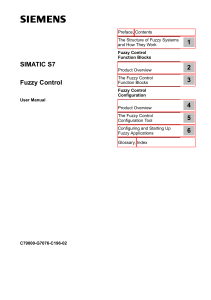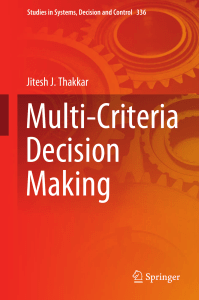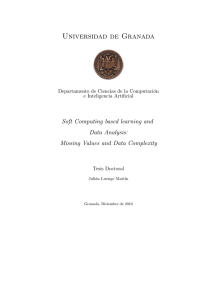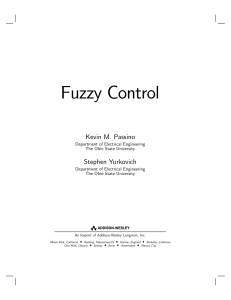a new approach to the synthesis of intelligible fuzzy models from
Anuncio
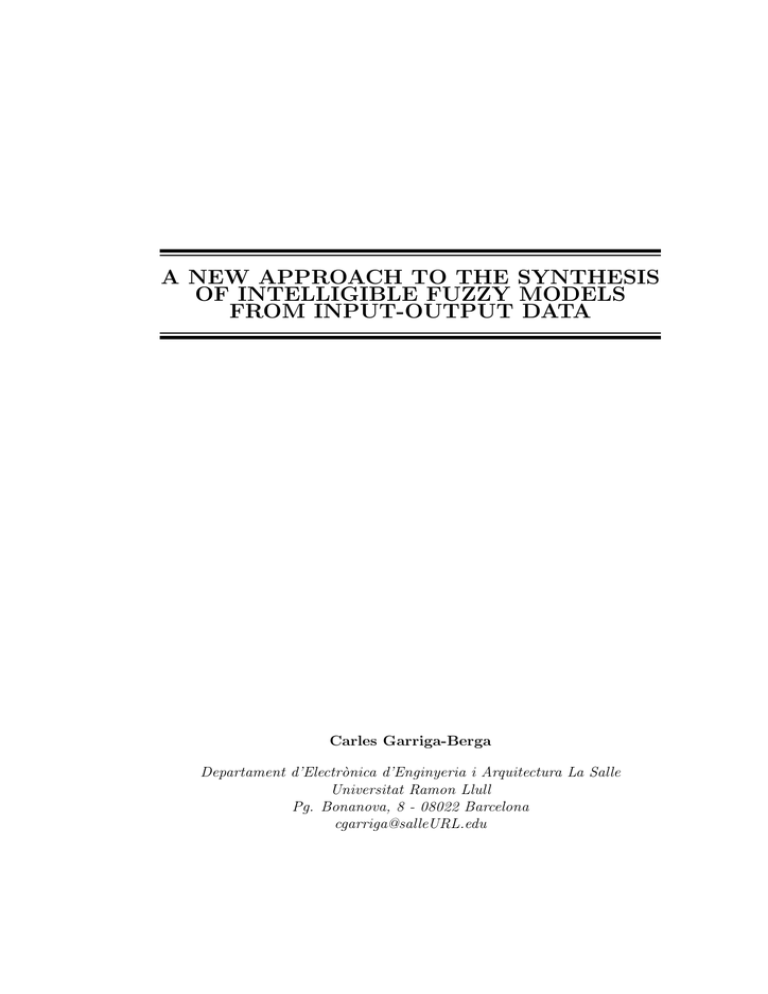
A NEW APPROACH TO THE SYNTHESIS OF INTELLIGIBLE FUZZY MODELS FROM INPUT-OUTPUT DATA Carles Garriga-Berga Departament d’Electrònica d’Enginyeria i Arquitectura La Salle Universitat Ramon Llull Pg. Bonanova, 8 - 08022 Barcelona [email protected] ii Dissertation for the Ph.D. degree in Electronic Engineering from Enginyeria i Arquitectura La Salle - Universitat Ramon Llull (URL) Preface This thesis has been written in English. In fact, when I had to begin the writing I had many doubts about the language I should use because English is not my native language, as you may notice from some expressions, for which I apologize. I am Catalan and I am proud of my nation and my language. At this point I remember the words one of the most relevant personalities in Catalonia, the musician, virtuoso cellist and conductor, Pau Casals, said in the United Nations in defense of truth, peace and freedom and against lies, repression and impositions1 . I believe all languages can be scientific languages. Not only they may be scientific languages but we must also promote their use in scientific domains. At this point I remember a clear example, given by a professor, in order to defend the use of all languages in the world of knowledge. She explained through several cases, how the destruction of many native languages in Africa after being absorbed by theoretically civilized cultures, caused the loss of many medical procedures which had been transmitted among generations by means of oral communication. 1 ”This is the greatest honour of my life. Peace has always been my greatest concern. I learnt to love it when I was but a child. When I was a boy, my mother - an exceptional, marvellous woman -, would talk to me about peace, because at that time there were also many wars. What is more, I am Catalan. Catalonia had the first democratic parliament, well before England did. And the first United Nations were in my country. At that timethe Eleventh Century - there was a meeting in Toluges - now France - to talk about peace, because in that epoch Catalans were already against, against war. That is why the United Nations, which works solely towards the peace ideal, is in my heart, because anything to do with peace goes straight to my heart. I have not played the cello in public for many years, but I feel that the time has come to play again. I am going to play a melody from Catalan folklore: El cant dels ocells. Birds sing when they are in the sky, they sing: ”Peace, Peace, Peace”, and it is a melody that Bach, Beethoven and all the greats would have admired and loved. What is more, it is born in the soul of my people, Catalonia” Pau Casals - October 24, 1971 iv Nowadays it is obvious that there is a dominant scientific language which contributes to the communication among the scientific community around the world. Anyway, none of us should forget the use of our language, in order to preserve our knowledge and to be deferent to our origins. The main reason for writing this thesis in English was in fact the defense of this multicultural need. This is not a contradictory purpose. On the contrary, the use of my native language would have been as feasible as English, but by doing so, I would have gone through much trouble in transmitting my knowledge and my worries to the scientific community. For this reason I encourage people to develop their scientific work in their native language and later let the dominant scientific language facilitate the communication between different cultures if necessary. But also for this reason I have a copy of this thesis in Catalan. Abstract Fuzzy logic has been applied successfully to systems modeling for ages. One of its main advantages is that it provides an understandable knowledge representation. Nevertheless, most investigations have focused their efforts on achieving accurate models and by doing so, they have omitted the linguistic capabilities of fuzzy logic. Thus nowadays, one can find theoretically humanfriendly fuzzy models which are usually very difficult to understand (or even impossible). This thesis researches into the issues related to intelligible fuzzy models, because since science demonstrated the use of fuzzy logic when searching optimal models in terms of error (in fact a fuzzy model is a universal approximator), some but few investigators have focused their efforts in order to achieve really intelligible models in spite of losing some accuracy. In this work we propose a whole methodology able to find an intelligible fuzzy model in a local manner (rule by rule) from input-output data. In this sense we find the number and position of the necessary fuzzy sets and also the linguistic rules related to them. For this purpose we have developed a hierarchical process which takes into account several steps and techniques, some of which are original contributions. The whole procedure has been studied in detail, as one may expect from a thesis, by arguing the different solutions we have considered in every step. The resulting method is very simple and also intelligible. Therefore, this solution performs the final models with a low computational cost, but furthermore, allows the tuning of its different options depending on the nature of the problem and the characteristics of the users. In this thesis we explain the whole methodology and illustrate its advantages (but also its problems) with several examples which are benchmarks in most cases. At the end we conclude that the objective of obtaining a simple but intelligible method able to give intelligible fuzzy models has been accomplished successfully. vi Abstracte La lògica difusa s’ha aplicat de manera eficient a molts problemes de modelat des dels seus orı́gens. Un dels seus principals avantatges és que facilita una representació comprensible del coneixement. No obstant això, la majoria dels investigadors han centrat els seus esforços en aconseguir models precisos i al fer-ho, han omitit les capacitats lingüı́stiques de la lògica difusa. Aixı́, avui en dia un pot trobar models difusos teòricament adreçats als humans però que normalment són molt difı́cils d’entendre (o fins i tot impossible). Aquesta tesi investiga els aspectes relacionats amb els models difusos intel.ligibles doncs des que la ciència va demostrar l’aplicació del modelat difús en la cerca de models òptims en termes de l’error (de fet un model difús és un aproximador universal), alguns però pocs investigadors han centrat els seus esforços en aconseguir models realment intel.ligibles tot i perdre certa precisió. En aquest treball proposem una metodologia completa capaç de trobar un model difús intel.ligible de manera local (regla per regla) a partir de dades d’entrada-sortida. En aquest sentit trobem el número i la posició dels conjunts difusos necessaris i també definim les regles lingüı́stiques que els relacionen. Per aquest propòsit hem desenvolupat un procés que paulativament té en compte diversos passos i tècniques, algunes de les quals són contribucions originals. El procediment complet s’ha estudiat en detall tal i com un es pot esperar d’una tesi tot argumentant les diferents solucions que s’han considerat en cada pas. El mètode resultant és molt simple i també intel.ligible. Per tant, obté els models finals amb un cost computacional baix però a més a més, facilita l’ajust de les seves diferents opcions segons la naturalesa del problema i les caracterı́stiques dels usuaris. En aquesta tesi expliquem la metodologia sencera i il.lustrem els seus avantatges (però també els seus problemes) amb diversos exemples que són referents en molts casos. Al final concloem que l’objectiu d’obtenir un mètode simple però intel.ligible capaç de donar models difusos intel.ligibles s’ha assolit satisfactòriament. viii Abstracto La lógica difusa se ha aplicado de manera eficiente a muchos problemas de modelado desde sus orı́genes. Una de sus principales ventajas es que facilita una representación comprensible del conocimiento. No obstante, la mayorı́a de los investigadores han centrado sus esfuerzos en lograr modelos exactos y han omitido las capacidades lingüı́sticas de la lógica difusa. Ası́, hoy en dı́a uno puede encontrar modelos difusos teóricamente orientados a los humanos pero que normalmente son muy difı́ciles de entender (o incluso imposible). Esta tesis investiga los aspectos relacionados con los modelos difusos inteligibles puesto que desde que la ciencia demostró la aplicación del modelado difuso en la búsqueda de modelos óptimos en términos del error (de hecho un modelo difuso es un aproximador universal), algunos aunque pocos investigadores han centrado sus esfuerzos en lograr modelos realmente inteligibles aun y perder cierta precisión. En este trabajo proponemos una metodologı́a completa capaz de hallar un modelo difuso inteligible de manera local (regla por regla) a partir de datos de entrada-salida. En este sentido determinamos el número y la posición de los conjuntos difusos necesarios y también definimos las reglas linguı́sticas que los relacionan. Para este propósito hemos desarrollado un proceso que paulativamente tiene en cuenta diversos pasos y técnicas, algunas de las cuales son contribuciones originales. El procedimiento completo se ha estudiado en detalle tal y como uno pede esperar de una tesis, argumentando las diferentes soluciones que se han considerado en cada paso. El método resultante es muy simple y también inteligible. Por lo tanto, obtiene los modelos finales con un coste computacional bajo que además, facilita el ajuste de sus diferentes opciones según la naturaleza del problema y las caracterı́sticas de los usuarios. En esta tesis explicamos la metodologı́a entera y ilustramos sus ventajas (pero también sus problemas) con diversos ejemplos que son referentes en muchos casos. Al final concluimos que el objetivo de obtener un método simple pero inteligible capaz de dar modelos difusos inteligibles se ha logrado satisfactoriamente. x Acknowledgements First, I would like to thank my supervisor, Dr. Xavier Vilası́s-Cardona, for giving me the chance to investigate in a field which impressed me a lot since I discovered its characteristics, and by providing me with continuous support throughout this work in order to achieve a satisfactory result. I would also like to remember my colleagues in the Electronics Department in Enginyeria i Arquitectura La Salle for those several discussions and those who have preceded me in this stage of our university activities. I would also like to mention other researchers all over the world, some of them anonymous, who have made several useful comments and suggestions during this work. Some of them I have met in congresses but many others have been met through the Internet and the new technologies. Finally I must have a consideration towards my family. At this moment I remember a citation: what one may accomplish in terms of professional career is quite meaningless compared to the importance of having children and not ruining their lives. Despite the belief that one can always find a good balance, I have to admit that this is a great truth. I am in debt with my family for their time I have stolen and thus, I dedicate this work to them. Carles Garriga-Berga Catalonia, June of 2005 xii Contents 1 Introduction 1.1 General background . 1.2 Problem statement . 1.3 Major lines of work . 1.4 Original contribution 1.5 Outline of this thesis . . . . . . . . . . . . . . . . . . . . . . . . . . . . . . . . . . . . . . . . . . . . . . . . . . . . . . . . . . . . . . . . . . . . . . . . . . . . . . . . . . . . . 2 Fundamentals 2.1 Fuzzy logic theory . . . . . . . . . . . . . . . . . . . 2.1.1 Universe of scope . . . . . . . . . . . . . . . 2.1.2 Fuzzy sets versus crisp sets . . . . . . . . . . 2.1.3 Properties of fuzzy sets . . . . . . . . . . . . 2.1.4 Fuzzy partitions . . . . . . . . . . . . . . . . 2.1.5 Basic operations with fuzzy sets . . . . . . . 2.1.6 Fuzzy relations and compositions . . . . . . 2.1.7 Fuzzy logic versus propositional logic . . . . 2.1.8 Fuzzy systems . . . . . . . . . . . . . . . . . 2.2 Types of fuzzy rule-based systems . . . . . . . . . . 2.2.1 Mamdani type . . . . . . . . . . . . . . . . . 2.2.2 Takagi-Sugeno type . . . . . . . . . . . . . . 2.2.3 Output singleton type . . . . . . . . . . . . 2.3 Criteria about intelligibility and accuracy . . . . . . 2.3.1 Trade-off between intelligibility and accuracy 2.3.2 Intelligibility criteria . . . . . . . . . . . . . 2.3.3 Accuracy criteria . . . . . . . . . . . . . . . 2.4 Summary . . . . . . . . . . . . . . . . . . . . . . . . . . . . . . . . . . . . . . . . . . . . . . . . . . . . . . . . . . . . . . . . . . . . . . . . . . . . . . . . . . . . . . . . . . . . . . . . . . . . . . . . . . . . . . . . . . . . . . . . . . . . . . . . . . . . . . . . . . . . . . . 1 1 3 5 6 6 . . . . . . . . . . . . . . . . . . 9 9 10 10 12 13 15 16 22 31 39 40 40 41 42 42 43 47 47 3 Methodology 49 3.1 Outline of the method . . . . . . . . . . . . . . . . . . . . . . 49 3.2 Grid partition of the UoS with rounded numbers . . . . . . . . 51 3.3 Optimal fuzzy curves . . . . . . . . . . . . . . . . . . . . . . . 53 xiv 3.4 3.5 3.6 3.7 3.8 Contents 3.3.1 Fuzzy curves . . . . . . . . . . . . . . . . . . 3.3.2 Optimal fuzzy curves . . . . . . . . . . . . . Input partition . . . . . . . . . . . . . . . . . . . . 3.4.1 Linearization of the fuzzy curves . . . . . . . 3.4.2 Round-off errors and rounded values . . . . 3.4.3 Odd fuzzy curves . . . . . . . . . . . . . . . Possible output sets . . . . . . . . . . . . . . . . . . 3.5.1 Wang&Mendel’s alternative . . . . . . . . . 3.5.2 Takagi&Sugeno’s alternative . . . . . . . . . 3.5.3 Removing rules not according to the samples rule matrix . . . . . . . . . . . . . . . . . . Clustering the possible output sets . . . . . . . . . 3.6.1 Fuzzy C-means . . . . . . . . . . . . . . . . 3.6.2 Hierarchical clustering: Chiu’s method . . . Criteria to stop the process . . . . . . . . . . . . . Summary . . . . . . . . . . . . . . . . . . . . . . . 4 Examples 4.1 Criteria to evaluate the methodology . . . . . 4.2 A nonlinear static function . . . . . . . . . . . 4.2.1 Problem statement . . . . . . . . . . . 4.2.2 A whole case in detail . . . . . . . . . 4.2.3 Analysis of results . . . . . . . . . . . 4.2.4 Model with highest accuracy . . . . . . 4.2.5 Comparisons . . . . . . . . . . . . . . 4.2.6 Summary . . . . . . . . . . . . . . . . 4.3 Predicting two popular time series . . . . . . . 4.3.1 Box and Jenkins’ Gas Furnace Data . . 4.3.2 Mackey-Glass chaotic time series . . . 4.3.3 Summary . . . . . . . . . . . . . . . . 4.4 Two popular control problems . . . . . . . . . 4.4.1 Truck and trailer . . . . . . . . . . . . 4.4.2 Ball and beam . . . . . . . . . . . . . . 4.4.3 Summary . . . . . . . . . . . . . . . . 4.5 Short examples . . . . . . . . . . . . . . . . . 4.5.1 The electrical network maintenance . . 4.5.2 Reproduction of a fuzzy system . . . . 4.5.3 Simplifying quasi-linear fuzzy systems . 4.5.4 Comparisons with ANFIS . . . . . . . . . . . . . . . . . . . . . . . . . . . . . . . . . . . . . . . . . . . . . . . . . . . . . . . . . . . . . . . . . . . . . . . . . . . . . . . . . . . . . . . . . . . . . . . . . from . . . . . . . . . . . . . . . . . . . . . . . . . . . . . . . . . . . . . . . . . . . . . . . . . . . . . . . . . . . . . . . . . . . . . . . . . . . . . . . . . . . . . . . . . . . . . . . . . . . the . . . . . . . . . . . . . . . . . . . . . . . . . . . . . . . . . . . . . . . . . . . . . . . . . . . . . . . . . . . . . . . 53 57 62 63 66 69 71 71 73 . . . . . . 77 79 80 81 84 85 . . . . . . . . . . . . . . . . . . . . . 87 88 89 89 90 100 103 103 104 104 104 110 114 115 115 125 131 132 132 134 136 139 Contents xv 5 Conclusions 143 5.1 Results . . . . . . . . . . . . . . . . . . . . . . . . . . . . . . . 143 5.2 Strong and weak points . . . . . . . . . . . . . . . . . . . . . . 144 5.3 Suggestions for further research . . . . . . . . . . . . . . . . . 146 A References 149 B List of publications 161 C Algorithms 165 xvi Contents
